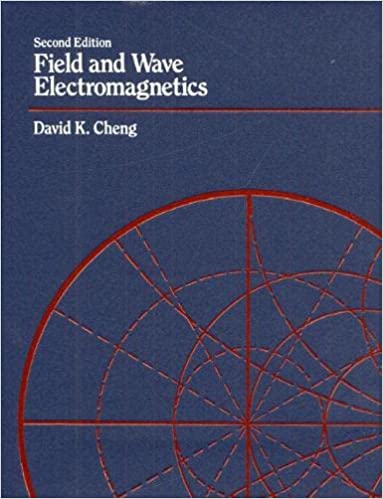
Field and Wave Electromagnetics 2nd Edition by David Cheng
Edition 2ISBN: 978-0201128192
Field and Wave Electromagnetics 2nd Edition by David Cheng
Edition 2ISBN: 978-0201128192 Exercise 104
Consider a section of a uniform transmission line of length
 , characteristic impedance Z 0 , and propagation constant between terminal pairs 1- 1' and 2- 2' shown in Fig. 9- 44(a). Let ( V 1 , I 1 ) and ( V2 , I2) be-the phasor voltages and phasor currents at terminals 1-1' and 2- 2', respectively.
, characteristic impedance Z 0 , and propagation constant between terminal pairs 1- 1' and 2- 2' shown in Fig. 9- 44(a). Let ( V 1 , I 1 ) and ( V2 , I2) be-the phasor voltages and phasor currents at terminals 1-1' and 2- 2', respectively.
(a) Use Eqs. a and b to write the equations relating Let ( V 1 , I 1 ) and ( V2 , I2) in the form
Equation (a):

Determine A, B, C, and D, and note the following relations:
Equaion(b):
A= D
Figure:
Figure (a): A line section of length
 .
.

Figure (b) : An equivalent two-port symmetrical T-network.

And
Equation (C):
AD - BC =1.
b) Because of Eqs. a, b, and c, the line section in Fig (a) can be replaced by an equivalent two-port symmetrical T-network shown m Fig(b). Prove that

and

 , characteristic impedance Z 0 , and propagation constant between terminal pairs 1- 1' and 2- 2' shown in Fig. 9- 44(a). Let ( V 1 , I 1 ) and ( V2 , I2) be-the phasor voltages and phasor currents at terminals 1-1' and 2- 2', respectively.
, characteristic impedance Z 0 , and propagation constant between terminal pairs 1- 1' and 2- 2' shown in Fig. 9- 44(a). Let ( V 1 , I 1 ) and ( V2 , I2) be-the phasor voltages and phasor currents at terminals 1-1' and 2- 2', respectively.(a) Use Eqs. a and b to write the equations relating Let ( V 1 , I 1 ) and ( V2 , I2) in the form
Equation (a):

Determine A, B, C, and D, and note the following relations:
Equaion(b):
A= D
Figure:
Figure (a): A line section of length
 .
.
Figure (b) : An equivalent two-port symmetrical T-network.

And
Equation (C):
AD - BC =1.
b) Because of Eqs. a, b, and c, the line section in Fig (a) can be replaced by an equivalent two-port symmetrical T-network shown m Fig(b). Prove that

and

Explanation
Refer to FIGURE 9-44(b) in textbook for ...
Field and Wave Electromagnetics 2nd Edition by David Cheng
Why don’t you like this exercise?
Other Minimum 8 character and maximum 255 character
Character 255


